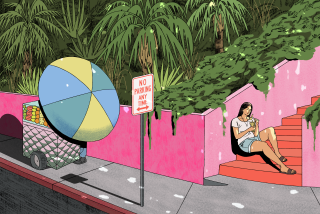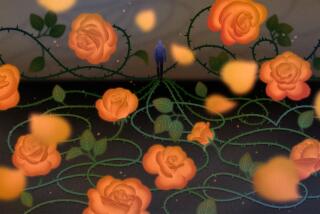When Tears--of Joy or Sorrow--Mark Memorable Parts of a Woman’s Journey
- Share via
Sometimes when I’m traveling, something touches me so deeply that I cry. My first sight of the Colosseum in Rome 10 years ago did that to me. I’d been jogging without really knowing where I was headed, and soon realized I was running by the Forum. At one point, I lifted my head, saw the great round amphitheater where gladiators fought, and I gasped--as if the heavens had parted and a spaceship had landed.
For five minutes, I stood there as cars honked and people stared, weeping silently, partly in amazement that it had endured for 2,000 years and partly in joy that I was there to see it.
For the record:
12:00 a.m. Sept. 24, 2000 For the Record
Los Angeles Times Sunday September 24, 2000 Home Edition Travel Part L Page 6 Travel Desk 1 inches; 31 words Type of Material: Correction
Her World: A column about crying (“When Tears--of Joy or Sorrow--Mark Memorable Parts of a Woman’s Journey,” Sept. 3) incorrectly identified Debra Borys as a Santa Monica therapist. She is a psychologist in Westwood.
I didn’t want to seem like a crybaby, so I kept the memory to myself for some time. But lately I’ve discovered that many women are moved to tears during their travels. Is it just hormones, or is it a matter of being overstimulated and overtired? Or are women really more emotional than men?
“I doubt men feel things any less, but women are freer about expressing their emotions,” says Carol Rivendell, a therapist and co-owner of Wild Women Adventures, a tour company for women based in Sebastopol. Rivendell also believes that women travel more slowly and aimlessly than men, so they notice when a moving moment occurs. Maybe it’s as Georgia O’Keeffe once said: “In a way, nobody sees a flower really, it is so small, we haven’t time--and to see takes time, like to have a friend takes time.”
Why certain sights affect us is a mystery, though I sometimes think they could be symbols of what we yearn for deeply. On a walking trip through the English Lake District at a confusing point in my life, I sat on a fence overlooking a landscape that seemed perfect, with heather-covered mountains, sheepfolds, thatch-roofed farmhouses and wild roses. There was an almost divine order in it, which, I suppose, is what made me cry. On the other hand, the lush, wet, tangled rain forest in Queensland, Australia, moved my friend Bernadette Doran of La Jolla to tears, suggesting that order is the last thing she craves.
Sometimes things move us because seeing them brings home a point, which is what happened to Debra Borys, a Santa Monica therapist, when she saw the waterlilies at Claude Monet’s home in Giverny, France, and thought of how the artist had painted them. “Suddenly I totally got it,” she says.
The same thing happened to me when I toured the Civil War battlefield at Gettysburg, Pa., and to my New York friend Penny Kaganoff on a bus tour in Jordan. There, Penny, a deep thinker and a rabbi’s daughter, climbed to the top of Mt. Nebo, where Moses saw the Promised Land after spending 40 years in the desert, shepherding his people out of Egypt. She knew that he died before reaching the Jordan River Valley. But atop Mt. Nebo, she fully understood how it would feel for “someone to work so hard for something but only get so far,” as she described it to me.
Nature writer Sy Montgomery was moved to tears when she canoed past an ant bird nest in the Amazon basin that contained two perfect, heart-wrenchingly vulnerable eggs. Sandra Gustafson, author of the “Cheap Eats” and “Cheap Sleeps” guidebook series, needed to take out her hankie when a B&B; owner made her hot chocolate one cold winter day just before Christmas in Vienna.
My friend Margaret Fleetwood of Montecito, who doesn’t cry easily, says that arriving anywhere by ship moves her, especially if it’s the small, exquisitely lovely, medieval-looking island of Malta. L.A. playwright Diane Lefer once made a pilgrimage to the convent of San Jeronimo in Mexico City to see the home of 17th century poet, essayist and scientist Sor Juana Ines de la Cruz, whom she admires. Sor Juana ran afoul of the Catholic Church; some of her enemies hoped to keep her from writing about women’s intellectual and spiritual gifts, which weren’t much appreciated at the time. The convent was shut, but there was a statue of Sor Juana outside, where Diane didn’t even try to stop the tears from flowing.
In other places, tears are obviously appropriate, as Evelyn Hannon, editor of the women’s travel Web site Journeywoman.com, discovered on a visit to the Warsaw ghetto, and as Antonia Neubauer, owner of the Nevada-based tour company Myths and Mountains, found at the site of the My Lai massacre in Vietnam. My young friend Alicia Dunams, who backpacked around the world last year, was moved when she came face to face with poverty and sickness in the Third World. “Traveling brings you up close and personal to such explicit human misery that it can make anyone cry,” Alicia says.
I think we need tears of this kind. And we also need tears for the beautiful, particularly when it makes us thankful. Marybeth Bond, editor of “Travelers’ Tales: A Woman’s World” and “A Woman’s Passion for Travel: More True Stories From a Woman’s World,” recently went to Africa with her daughters, Julieclaire, 12, and Annalyse, 9. She found that what moved her most was seeing the continent and its people through her girls’ eyes. As Julieclaire and Annalyse met their longtime pen pals in a Tanzanian village and played soccer with them, Bond gave thanks that she could give her daughters this experience.
The golden moment that makes some of us cry is, at heart, religious, according to the Rev. Susan Klein, rector of St. Aidan’s Episcopal Church in Malibu--and also my sister-in-law. Some years ago, she traveled through the Holy Land, where, among other things, watching the sun set on Maundy Thursday before Easter on the Mount of Olives, where Jesus prayed before his arrest and ordeal, brought tears to her eyes. She says that travel often delivers up divine moments “provided we have the hearts to receive them.” One of the things that separates humans from animals, she says, is the ability to say thanks, which is what happens to many of us when we see the Colosseum, Mt. Nebo or Malta.
More to Read
Sign up for The Wild
We’ll help you find the best places to hike, bike and run, as well as the perfect silent spots for meditation and yoga.
You may occasionally receive promotional content from the Los Angeles Times.






